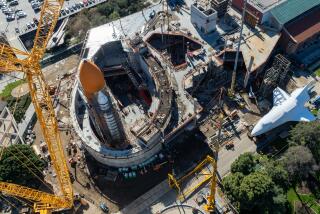Endeavour Gives a Wide Berth to Derelict Air Force Satellite
- Share via
KENNEDY SPACE CENTER, Fla. — Endeavour’s astronauts fired the space shuttle’s thrusters Friday to steer clear of a 350-pound piece of space junk as they closed in on a Japanese satellite they plan to bring home.
The junk, a defunct Air Force satellite, would have passed within eight-tenths of a mile of the shuttle--too close for NASA’s comfort. But with the evasive action, the two remained at least six miles apart.
Flight director Jeff Bantle said controllers had been tracking the satellite for hours. Though a collision was unlikely, flight safety rules required Endeavour to move, and commander Brian Duffy changed course 1 1/2 hours ahead of time.
A head-on collision almost certainly would have destroyed Endeavour and killed all six astronauts, given the orbital speed of the two craft--17,500 mph each.
“It was no big deal,” Duffy said.
It was the first time in 2 1/2 years that shuttle astronauts had to take evasive action in space. In 1993--Duffy’s previous flight, also on Endeavour--the shuttle avoided a close encounter with a 28-year-old spent Russian rocket.
This time, it was a satellite nicknamed Misty, launched from Vandenberg Air Force Base in California in 1994 to track ballistic missile targets. The Air Force lost contact with the satellite after only four months of operation.
“I guess we found it,” Duffy joked. He said it remained too far away for the crew to see.
The satellite is one of nearly 8,000 orbiting man-made objects, grapefruit-size and larger, being tracked by the U.S. Space Command in Colorado Springs, Colo. Most of that is junk: dead satellites, spent rocket bodies, spacecraft fragments.
The maneuver came on Day 2 of Endeavour’s nine-day flight. On Saturday, the crew plans to capture the science satellite that the Japanese put into orbit last March.
More to Read
Sign up for Essential California
The most important California stories and recommendations in your inbox every morning.
You may occasionally receive promotional content from the Los Angeles Times.













